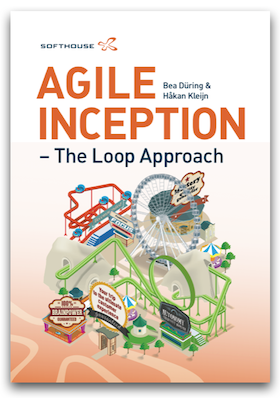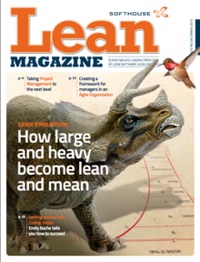She may have been the first person in the world to connect the concepts ”Agile” and ”HR”. Now it is becoming clear that Pia-Maria Thorén of Stockholm-based GreenBullet was the trailblazer of a global movement.
Pia-Maria Thorén is as multi-professional as they come – she usually describes herself as a hybrid between HR, IT, Finance and Management. Being the Inspiration Director at the Agile consulting company GreenBullet, Thorén not only has a busy time serving her clients. She is also, as she has become a major influencer in the areas of Agile HR, leadership and motivation, a popular invited guest at conferences and participates in numerous interviews in podcasts and blogs. In a personal, informal way—Scandinavian-style— she makes it very clear that leadership in the global industry needs to change.
Hi Pia-Maria! Have you ever felt that you established yourself too early in this field?
“Oh yes! We are still in the early days of agile HR but I have been running my course since 2010, so maybe eight years too soon! Now finally the world is catching up, but there is still a long way to go before all HR people wake up and realize the need and what to do about it.”
In March 2018, Harvard Business Review published the article “HR Goes Agile”. What was the significance of this, in your opinion?
“The article as such was not very mindblowing or fantastic in my opinion. But it did help to create a broader awareness around a topic that most people had not paid any particular attention to until the article came out. And it was probably because it was published in HBR that it drew a lot of attention. I saw a change in the incoming flow of contact requests and emails as a result of that article, although I had been preaching the same message for 8 years already. So the effect was that people suddenly realized that to be able to have a truly agile company, you need to have both HR and leaders onboard with the agile value system so that they can adapt their work and processes accordingly.”
Are we entering a global crisis for traditional business management?
“Oh yes! Traditional management— the controlling and micromanaging kind—played out its role a long time ago. But regardless of that, companies have been holding on to the old ways of managing and organizing things. We have now reached a point in most companies where it’s no longer possible to manage in traditional ways. Accordingly, the servant leadership, agile leadership, transformational leadership or whatever you choose to call it becomes a must. This is because we need to tap into our co-workers’ motives and passion and engage to get the most performance and dedication out of them.”
“As a matter of fact, a paradigm shift is happening right now. We see large organizations trying to move to more agile ways of working. Their continued success can only be ensured if the complexity within the organization manages to match the complexity of the external world. The companies who fail to achieve this shift will slowly fade away and die as there will be other, more fast-moving companies who will take their place.”
Please explain the key role of HR when businesses are entering an agile transformation process.
“I always say that there is one functional department in most large organizations that can affect all of the other departments at the same time: Central group HR. All the areas which it controls (see box) cut through the whole organization. They constitute the processes that can support or stop the change to a more agile future. And it all depends on how we work with these processes and programs. Either you can develop them in a way that will limit performance and engagement, or you can choose another, more agile way of working with these areas, where you optimize performance and employee satisfaction.”
There are two perspectives on Agile HR:
1. HR internal methods and ways of working (HOW should HR work?). Here we see more cross-functional work and using agile tools such as Scrum and Kanban. Including customers (i.e. managers and employees) in the delivery process is key.
When traditional HR departments work in Silos, the agile HR department work together and the focus is on delivering value to customers in cross-functional teams.
2. HR deliverables (WHAT should HR deliver to(gether with) the business). The programs, coaching, ways of working etc. should be agile in themselves. This means that no one-size-fits-all control processes are delivered anymore. Instead the deliverables support flexibility, adaptability and speed.
Please explain the importance of the IT/HR cooperation.“HR has been struggling lately with criticism of being some kind of organizational police whose processes, though designed to improve performance and engagement, are actually counter-productive and have the opposite effect of hindering performance and engagement. And I believe that this needs to change. HR has been sitting in the backseat for too long now. It’s time to step up and take responsibility for change, in a way where you show what you can really do for the organization.
It’s all about the people, the relationships and the system in which the people live and work. If we provide people with the right conditions, they will take care of the rest.”
“These two groups have a lot to learn from each other and increasing collaboration will bring great value to both parties and therefore also to the end customer (the business). IT is good at automating stuff and HR is good at understanding people, so ideally the scrum masters should report to HR. When Agile is brought to the larger organization, it does not make sense for scrum masters to report to the CIO. HR can learn Agile from IT, and IT can learn about people from HR – so starting to work cross-functionally is the best advice!”
- Thinking it’s about frameworks and models, when it’s all about culture and values.
- Performing mass-training but not doing (and learning from this doing).
- Underestimating the time and solidness it takes and expecting miracles in 3 or 6 months.
Pia-Maria Thorén
Pia-Maria is the founder and owner of GreenBullet, and specialize in Agile HR, Agile leadership and Motivation. She has worked as a consultant with many of Sweden’s largest companies, helping them to implement HR processes and solutions, always spiced with an agile mindset.



